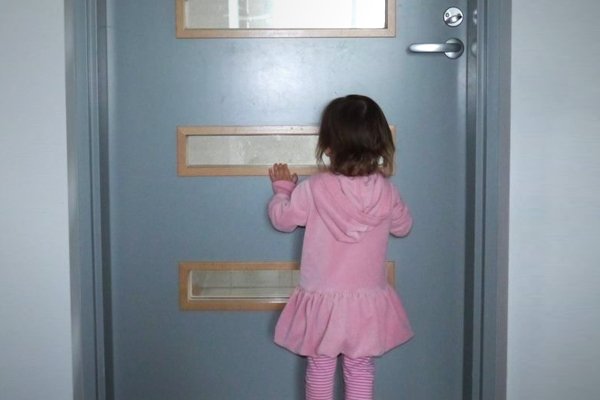Bye-Bye Girl: Supporting Children and Families with Hellos and Goodbyes


I’m packed and headed out the door on a weeklong business trip. This will be the longest I’ve ever been away from my daughter, Annalei. I’m trying so hard not to cry too much in front of her, knowing that my parental job in this moment is to (somewhat) keep it together and support her as we say good-bye. She has no idea what a “week” is or that when I walk out the door she won’t see me for several nights. Her wonderful teacher, Maranda, gives me an empathetic smile and touches my arm. “Mommy, mommy, mommy,” Annalei says over and over again while we hug and I say my good-byes, quiet tears trickling down my cheeks. Maranda kneels down next to Annalei and puts a hand gently on her back. As I leave, I turn to wave good-bye one last time. Annalei furrows her little brow, raises her hand in the air and says, “Bye-bye girl.” After a couple of shaky breaths, she reaches up, grabs Maranda’s hand, and leads her teacher to a basket of toys.
For young children and their families, hellos and goodbyes can be an extremely emotional experience. Whether they’re saying goodbye for a few hours or for a few weeks (or even longer), there are strategies we can use to support the transition, acknowledge their feelings, and ease the pain.
Here are some ideas from The Creative Curriculum for Infants, Toddlers & Twos and from my own classroom experience for supporting children and families during hellos and goodbyes:
Get to know families well. In some cultures, people believe that very young children should be able to function separately from their families. Other people believe that a mother should never be separated from her infant. As you work with families, try to get to know each family’s beliefs and values so that you can best support them during this transition.
Allow enough time during hellos and good-byes to meet individual needs without rushing. Drop-off time can be a particularly hectic time of day for you and for families. Make sure you are free from other tasks (like prepping the classroom materials) so that you can be available to children and families who need your support.
Spend time with each child and his or her family before the child is left in your care for the first time. As families get to know you, they will feel more confident about leaving their child in your care. Children will also feel more comfortable with you when they see you interacting positively with their families.
Photograph family members in your setting. Take photos of family members playing and reading with children in the classroom. Place the pictures where children can see them easily. These photos are another way to show children that their families are an important part of your classroom community.
Have families leave something that clearly belongs to them at the program. An object that belongs to a family member is a reminder to the child that his or her family member will be back. A parent might say to the child, “I’m leaving the book I’m reading with you. Will you keep it with your things so we can get it when I pick you up?”
Participate in the rituals that children and families develop. Whether it’s having the same hug and kiss routine every day, waving goodbye from the window, or taking part in two high fives and a “see you later alligator” language exchange, engaging with children and families in their familiar ritual can offer them great comfort. I had a particularly playful father and son in a twos room where I was doing an internship in college. They would give each other kisses and high fives and then Dad would bend over and his son would push him out the door saying, “Daddy, time for work.” Rituals help children—and adults—feel more secure, because they know what to expect.
Place pictures of family members around the classroom where children can easily see them throughout the day. In one toddler program I worked in, we had a lower ceiling over the diaper-changing table, so we covered it with photos of the children’s families. During diaper changes, the children would look up at the pictures and we’d talk about their families. Since I always steal my best teacher ideas to use at home, I did the same thing in my daughter’s room on the ceiling above her changing table. It is important to me that she has a secure attachment to Maranda, the teacher whom I mentioned at the beginning of this post. So among the family pictures is a big picture of Maranda holding Annalei and smiling. It shows my daughter that Maranda, and by association teachers, are just as important to us as family.
Encourage families to always say good-bye. When a child has difficulty saying goodbye, it is tempting to rush through the process or to distract the child while the family member leaves. However, doing so might lead the child to distrust you and may make separation even more difficult.
Be empathetic. You want the child to know that you understand how she feels and that you will help her with her feelings. With children under 3, it is important to show your empathy with your facial expressions and the inflection and tone of voice you use. They may not understand all of your words, but young children can get meaning from other communication cues. “You are sooo sad because Mommy left. You love your Mommy. You love her sooo much,” you might say, with a furrowed brow and a concerned tone of voice.
As adults, we sometimes worry that emphasizing a child’s sadness will make a child sadder, so we try to distract children from their feelings, for example, by saying, “It’s okay. Let’s play with this bear. Isn’t the bear cute?” This can have unintended consequences: the child learns that her feelings are not appropriate or aren’t important to us and, as a result, those feelings can intensify, as if to say, “You don’t get it. I don’t want the silly bear. I want my mommy. My mommy. Don’t you understand?” Instead, when we empathize with a child, we show them that we understand what they are feeling and that we value their feelings. This supports children’s social–emotional development and strengthens our relationships with them.
I liken it to my very adult experience of having to say good-bye to my former spouse before he would deploy. We were together for 17 years and he was in the military the entire time. We’ve been through a lot of separations. But every time he left, I was a wreck—a sobbing, blubbering, miserable wreck. If I were to call a friend to talk about it, one of the worst things she could say is, “Oh, it’s ok. He’ll be back. Hey, why don’t we go shopping so you can forget all about him?” What I needed in that moment was not distraction, but rather someone to empathize with my feelings of sadness and loss and worry. These are the very same feelings many young children have when their most special person in the world leaves them to go to work.
Reassure families after a difficult departure. Try to call, text, or email family members during the day to let them know that their child is fine and to explain what you did to comfort the child after they left. This kind of communication is reassuring and builds trust.
The text Maranda sent me (after my very sad good-bye with my daughter) told me about all the activities Annalei participated in that morning. The message ended with, “She’s sleeping peacefully now. Have a good trip. I’ll make sure your precious one is cared for.”